Octagonal Houses of Rhode Island
Eight walls to enfold you.
by Louis McGowan, with additional material by Christopher Martin
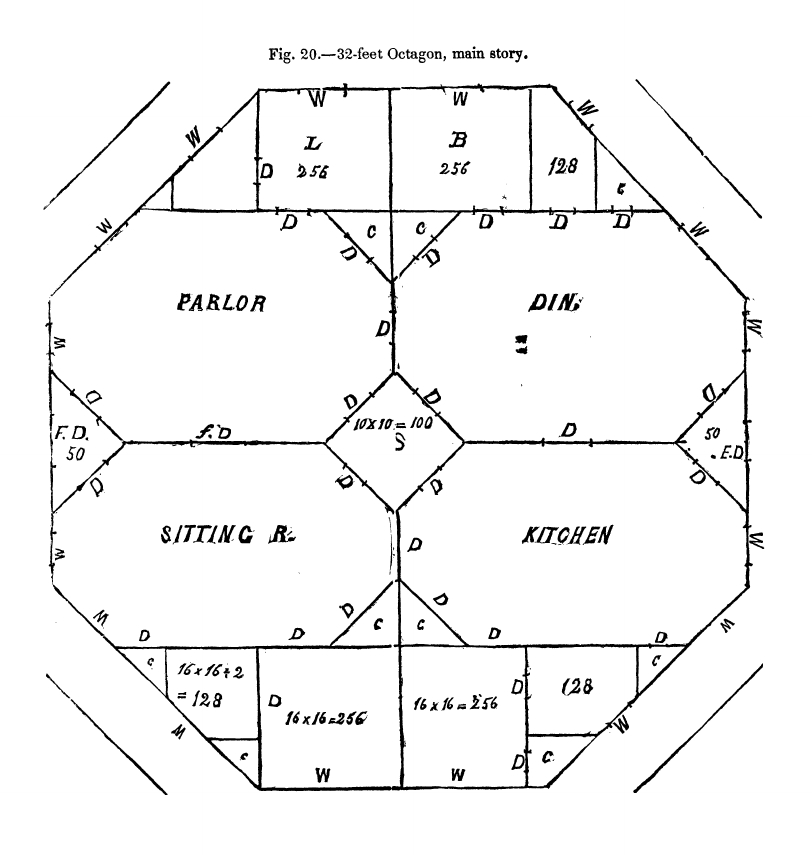
No one knows who came up with the design for the first octagonal building or even where the first one was located, but they appeared by Roman times. Octagons showed up occasionally over the centuries, usually as public buildings. A Dutch trading post in New Jersey in the 1630s used this shape, and some Dutch churches in this country were of an octagonal shape. Octagonal block houses were built by the Russians in Alaska in 1804 and by the United States in Wicassett, Maine, in 1808. A fine early example of an octagonal house in this country is Thomas Jefferson's summer house, Poplar Forest, in Virginia, which was completed in 1819 from designs by the president himself. The octagon style was not commonly used, though, especially in domestic architecture, and it took an American named Orson Squire Fowler, a noted reformer of his time, to popularize the idea of using this shape for people's houses.
In 1849, Fowler published his book on octagonal houses: The Octagon House: A Home for All, or A New, Cheap, Convenient, and Superior Mode of Building. The book, a "hit" at the time, extolled the virtues of these houses. Fowler stated that the octagon was the building shape that most closely resembled nature's perfect form, the circle. The circle, though, is a difficult shape to deal with in building inexpensive houses, and Fowler was concerned with coming up with a design that poor people and rich people alike could duplicate. The octagon seemed to fit the bill, being close to a circle in shape, but much easier to deal with for a house builder. Fowler felt that octagons were beautiful to look at, cheaper to build, enclosed more interior space per linear foot of exterior wall than conventional houses, eliminated "useless corners," and led to a healthier life-style because they included a cupola for ventilation and provided better lighting for the interior space by having windows on eight sides. He also believed that octagons were better at conserving heat because the increased interior space required less exterior wall. The use of a spiral staircase in the center of the house would provide for the circulation of fresh air in the summer and heated air in the winter. He also pioneered a new, inexpensive technique for house construction which used gravel, lime, and sand to create concrete which could be poured into molds for the exterior walls of the house.
In the mid-nineteenth century, Americans were fascinated with exotic architecture. We were on the tail end of the Greek Revival period, which was a classically beautiful style, but not too showy. Designers flirted with diverse styles such as found in Egyptian Revival, Gothic Revival, and Moorish designs. Many Americans were ready for the octagonal house. It was attractive, unusual, and lent itself to ornamentation that could be taken from many architectural styles, such as Georgian, Greek Revival, Gothic Revival, and Italianate. The plans also could be adapted for small or large houses. The greatest of all octagonal houses was the magnificent ninety-foot-tall, four-story one which Fowler built for himself in Fishkill, New York, overlooking the Hudson River. His house had sixty main rooms and forty other miscellaneous rooms and closets.
Octagonal houses began to be built from New England to Wisconsin. They were never found on every block, but probably a few thousand homes were built in this style, mostly from 1850 to about 1865 (the fad did continue into the 1890s, but at a slower pace). In the April 2006 issue of Rhode Island Monthly, the claim is made that about seventeen Fowler-inspired octagons were built in Rhode Island in the mid-nineteenth century. Home-builders had plans to go by in Fowler's book and in other pattern books of the time.
At first, Fowler's preferred method for building octagonal homes was with outside wood plank walls. He later came upon the aforementioned gravel-wall or poured concrete technique, which he claimed was cheaper to build with. Revisions were then made to his book extolling the virtues of building with concrete. Most octagonal houses were actually built of brick or wood, though, and probably cost more, it seems, to build because the builders had to adapt these materials to the 135-degree contours of the octagon. The room arrangement was also a problem. Fowler's designs called for wedge-shaped or triangular rooms. Using rooms with this shape meant that you still had three useless corners in each of them. Most rooms in an octagonal house also had only one exposure, rather than the two found in conventional homes, so Fowler's design did not really help to get more light into the living space.
Despite these objections, the octagonal house was relatively popular in the mid-nineteenth century, and today, many of us look at them fondly and seek them out to admire. Quite a few of the octagons have disappeared. Some students of the octagonal house style estimate that only a few hundred are left in the country. However, a fall 2005 paper in the Crooked Lake Review by John H. Martin, entitled "Saints, Sinners and Reformers," states that 2,077 octagonal houses still stand today. In the period between about 1986 and 2006, at least two octagons were torn down in Rhode Island, but we are lucky to still have a few octagonal homes left in our state to appreciate.
A listing of Rhode Island's octagon houses follows. Round houses have been included in the list, as they are closely related to the octagonal houses (as stated above, Fowler considered round to be nature's ideal shape). Some round and octagonal buildings of undetermined use have also been included for now. They are depicted on early bird's eye view maps and may have been gasometers (structures used to hold gas, produced by burning coal). Merry-go-round buildings have not been included.
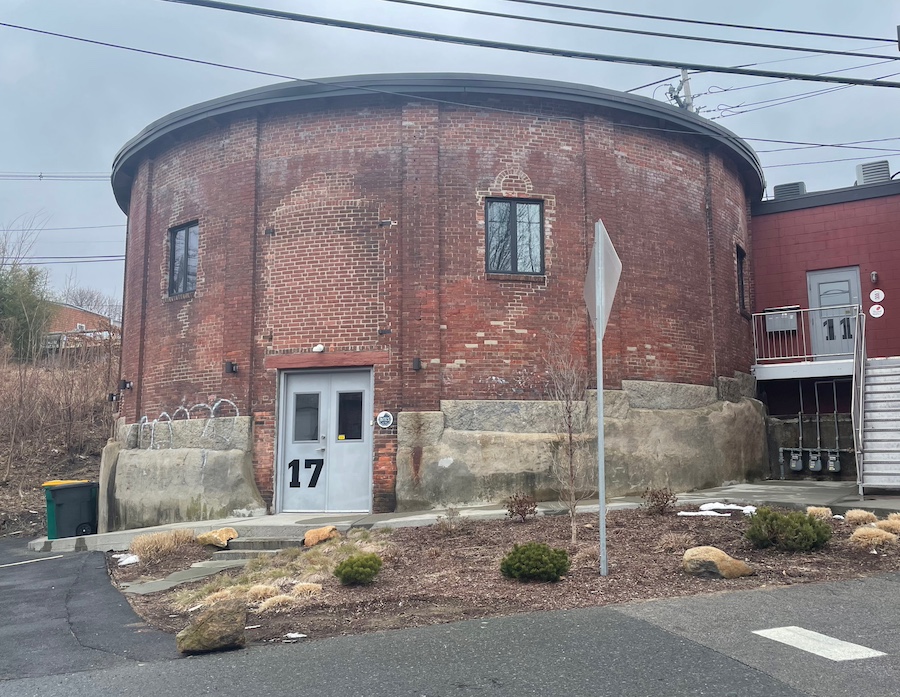
An Inventory of Octagonal and Round Houses
- Bristol. This home, known as the Lemuel C. Richmond House, is located at #41 High Street. It was built in 1856 by Mr. Richmond and is the only octagon ever built in Bristol. Possessing an elaborate bracketed porch, it was enlarged with a hexagonal kitchen addition on the northwest and a south bay in the 1870s. A north wing was added in the twentieth century when the house was owned by LeBaron Bradford Colt. The house has stuccoed walls which are eighteen inches thick upstairs and twenty inches thick on the first floor. Some of the walls are poured concrete, some are filled with loose sand, rubble and gravel. It is, besides the Richmond octagon (see below), the only other octagonal house in Rhode Island with its original cupola. A chimney extends up through the cupola.
Zillow link
41 High Street, Bristol. (April 29, 2006).

An 1891 bird's-eye view map showing the High Street octagon.
Detail showing the cupola and chimney at 41 High Street, Bristol. (April 29, 2006). - Burrillville. A relatively new (1991) two-story dodecagon (twelve-sided structure) stands at 720 Gazza Road.
Zillow link.
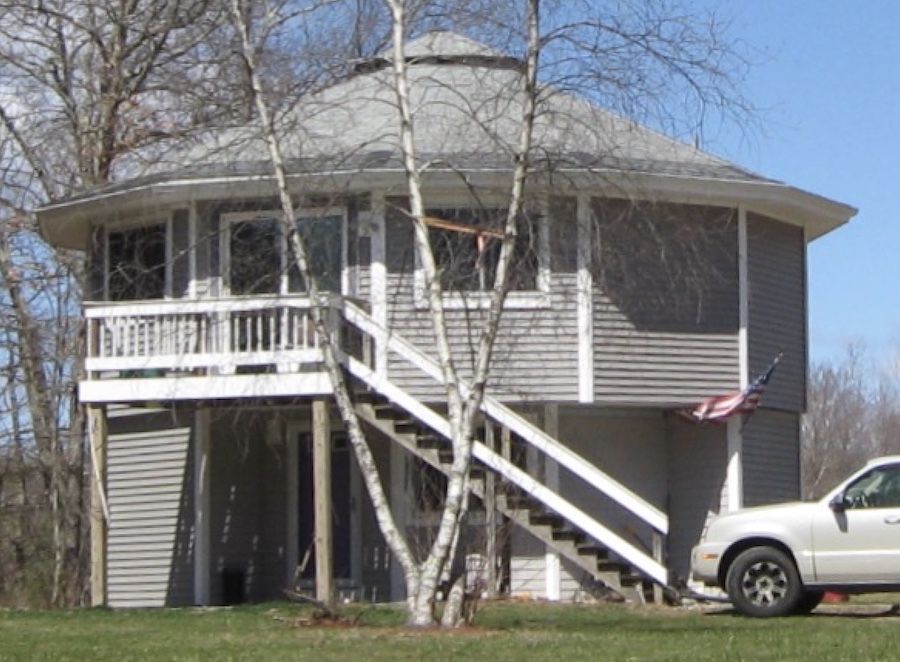
Gazza Road, Burrillville, octagon. (April 11, 2020). - Coventry. 50 Harrington Road is a private residence, perched at the end of a small peninsula on Lake Tiogue. It was built around 1990.
Zillow link

Harrington Road octagon. (September 7, 2020). - Cranston. The house is located at 80 Phenix Avenue. Cranston at one time had three octagonal houses, but only this one survives. The Cranston RIHPHC report lists this as the Battey House, built circa 1854. In 1870, the house was owned by Judge Sheldon Knight, a judge of the Probate Court. Amos and Lydia Williams bought the house in 1880, and around 1925, Gennaro Senapi purchased the property. His family owned it at least into the 1970s. Today, there are four apartments in the building. This two-story building has been much changed. A large, full, two-story addition has been erected on the rear side of the building, and the whole structure has been aluminum-sided. There is no cupola and only a small, central, square chimney is to be found on the roof.
80 Phenix Avenue, Cranston. (April 29, 2006).
Another view of 80 Phenix Avenue, Cranston, showing the large addition on the back. (April 29, 2006). - Cranston. The house was located in the village of Auburn and was said to have been built by Erza Read, a local developer. He laid out many of the streets in Mashapaug and first called the area Auburn. The house was demolished in the 1970s. (Details from Gladys W. Brayton's Other Ways and Other Days, her look back at some of Cranston's history. It was written in the early 1970s). The house is mentioned in passing in the Cranston RIHPHC report.
- Cranston. Location unknown. Mentioned in the Cranston RIHPHC report.
- East Providence. The house, situated at 21 Sunnyside Avenue, was originally the bandstand for the Boyden Heights Amusement Park, which was located in this area. A circa 1908 postcard view of the bandstand shows it to be a two-level building. The bottom level was enclosed and seems to have been a store. The top level was open and was where the band set up. The bandstand was probably built about 1907. The park closed circa 1910, and the bandstand was converted to a private residence by 1916. A recent visit (2006) shows the house to be a two-story, shingled, pagoda-roofed building (two different pitches), with a small addition on the south-west side and a first floor porch on the north and north-west sides.
Zillow link

A postcard view of the house when it was the bandstand for the Boyden Heights Amusement Park, circa 1908. From the collection of Louis McGowan.
The house at 21 Sunnyside Avenue. Note the double-pitched roof. (April 29, 2006). - East Providence. Built in 1990, 163 Halleck Avenue is a small two-story octagon with adjacent octagonal one-car garage overlooking upper Narragansett Bay.
Zillow link

Halleck Avenue octagon. (Louis McGowan, March 15, 2020).
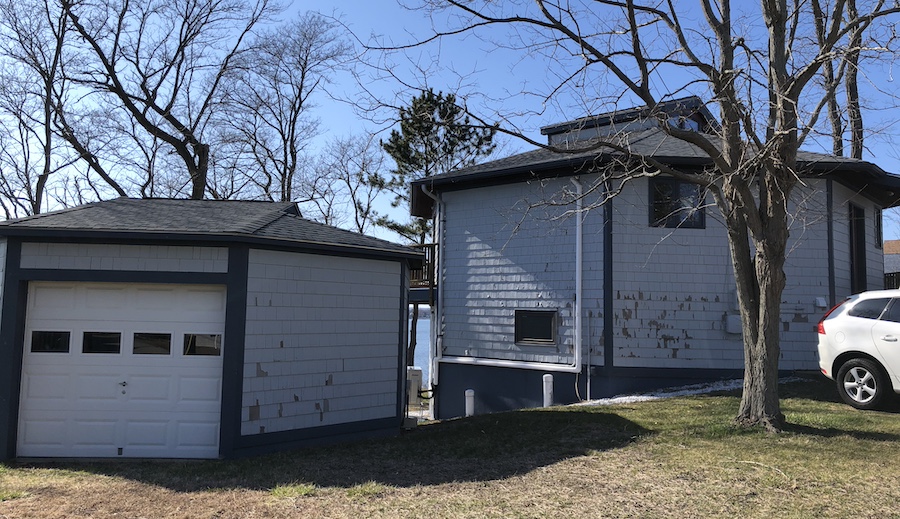
Halleck Avenue octagon with adjacent octagonal garage. (Louis McGowan, March 15, 2020). - Foster. Briefly mentioned in the Foster RIHPHC report as "a large reinforced concrete octagon house on Potter Road." According to Zillow, it was built in 1981.
Zillow link

Foster octagon. (Zillow, 2021).

Foster octagon. (Google Satellite View, 2024). - Jamestown. The Daniel S. Newhall House, a three-story, round structure, was erected between 1886 and 1888 at 104 Racquet Road. It was mentioned in Carl Schmidt's More About Octagons. The wood-frame house was probably built by Charles Follen McKim, the esteemed architect. On the first floor were servants' quarters and the kitchen. Above these were the family rooms, including a large rectangular living-dining room in the middle. Six bedrooms opened off this room. At the top of the house was a deck with a magnificent view of Newport Harbor. A 1991 fire damaged the house, but it was rebuilt.
Zillow link
The Jamestown "Round House." Historic and Architectural Resources of Jamestown, Rhode Island (1995) notes that "The shape... resembles that of old Fort Dumpling, which stood above the ocean nearby." (July 17, 2010). - Johnston. The house was located on the old Ochee Springs property at Hartford Avenue near Killingly Street. In the 1880s and 1890s, it was owned by Horatio N. Angell. It was later owned by the Ochee Springs Bottling Company and rented out. The house was demolished in the 1960s when a Route 195 exit ramp was built nearby.
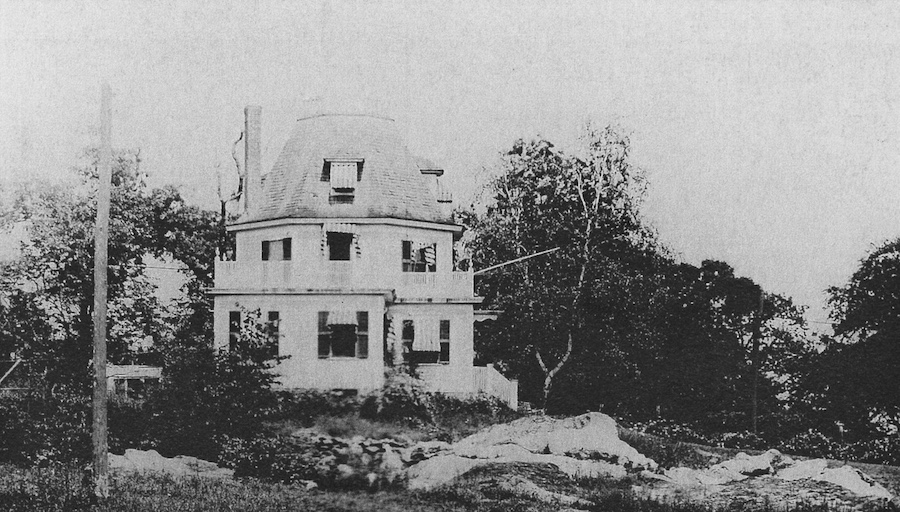
Johnston's octagon. From Images of America: Johnston Volume II by the Johnston Historical Society (1999), (Rhode Island State Archives). - Middletown. This was a round house built in 1854 (although other authors such as Antoinette Downing date it to as early as 1840), and razed after 1952. It is said to have been built by Christopher S. Southwick. A two-story, wood frame house with a cupola, its interior plan showed three approximately equal oval rooms around a curving hall. Southwick is said to have come up with this idea while at a dance in a square house. He felt the couples could not swing freely enough to the music in square or rectangular rooms.

The exterior, entry hall and stairway, and first floor plan of Middletown's round house. (Photos by Robert Meservey from The Architectural Heritage of Newport, Rhode Island by Antoinette F. Downing and Vincent J. Scully, Jr. (1952)). - Pawtucket. Jesse S. Thornton, a Pawtucket businessman, began building this octagon house in 1856. He died before the house was finished, and his brother, Simon E. Thornton, finished it and lived in it until 1870. The Field family and the Sutcliffe family lived in the house after this. In the mid-1950s, the house was demolished. A low-rise medical office building has been built on the site, next door to St. Paul's Church on the east side of Park Place.
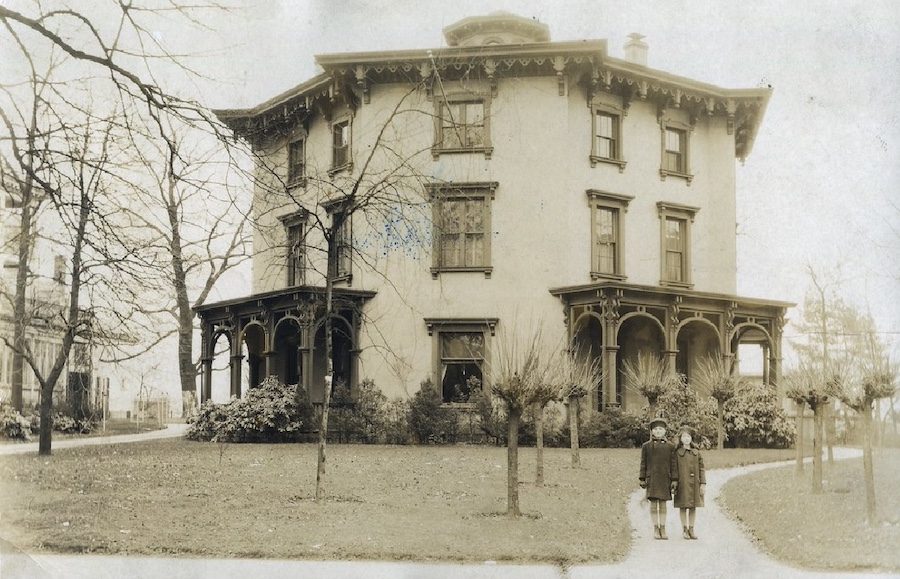
42 Park Place, Pawtucket, octagon. (Unknown source, undated).
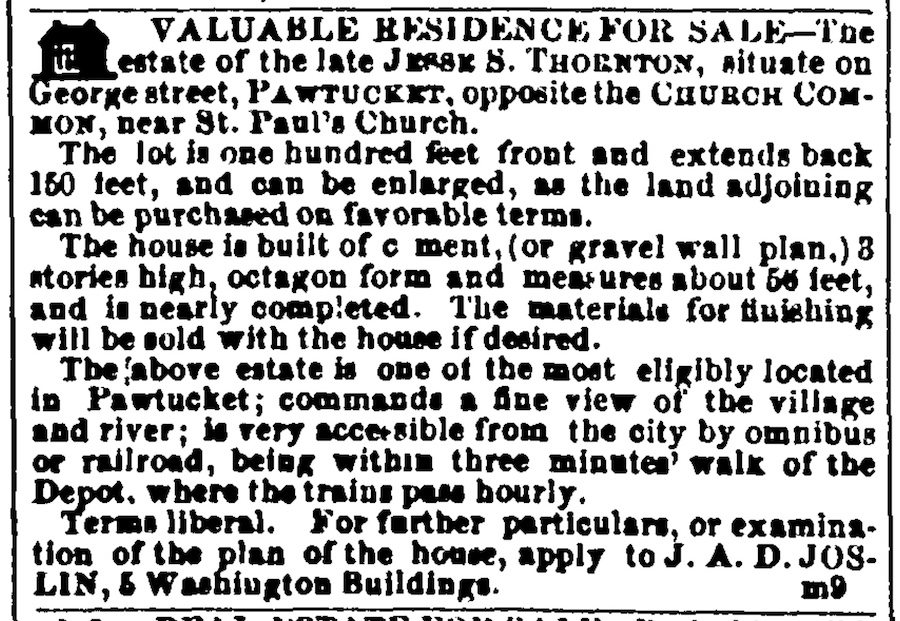
Ad offering the Thornton octagon for sale. (Providence Journal, July 2, 1857). - Providence. The Eliza H. Dix House, built in 1855, is located at 36 Crescent Street, overlooking Mashapaug Pond. It is a two-story octagon, formerly with a bracketed cornice, and a stuccoed, octagonal, center chimney. (A modern application of vinyl siding over the whole building resulted in the removal of the cornice bracketing). The pitch of the roof is steeper than the Public Street example (see below). A modern deck and a wrap-around porch have been added.
Zillow link
36 Crescent Street, Providence. (April 29, 2006).
Detail of 36 Crescent Street, Providence, showing the octagonal chimney. (April 29, 2006). - Providence. The Silas M. Field House, located at 63 Elmwood Avenue, was built about 1857. It is a three-story, mansard-roofed, stuccoed-stone building, and is Providence's largest octagonal house. The mansard roof and the cornice have been aluminum-sided. There are double windows on the first two floors. No cupola is present, although what looks like the base of one can be seen. Field was a jeweler, who lived here until he died in 1886. His son Silas E. Field was also a jeweler and lived here until 1900.
According to Zillow, the first floor consists of two one-bedroom apartments and one studio; the second floor includes two one-bedroom apartments; and the third floor includes six individual rooms served by a common bathroom, boarding house style.
Zillow link
63 Elmwood Avenue, Providence. (April 29, 2006).
A look at the front door of 63 Elmwood Avenue. (April 29, 2006).
Another view of the Elmwood Avenue house. (April 29, 2006).

An overhead view shows the footprint of the cupola on the roof, as well as a sizeable addition at the rear of the house. (Google Satellite View, 2024). - Providence. The house, a three-story condo built in 1988, is located at 76 Harrison Street. From original plans, the house was split down the middle to make four duplexes. One of the partners in the condos, Mark Van Noppen, said that "The design came partly out of a fascination with Fowler." In keeping with the octagon theme, when the roof was completed on August 8, 1988, the partners threw a party featuring octopus on the menu and music played on a piano (which of course has eighty-eight keys).
Zillow link
A modern take on Fowler's eight-sided design, located at 76 Harrison Street, Providence. (May 15, 2004).
Click here for more information, including construction photos from 1988. - Providence. The house was located at 241 Ives Street. It was torn down approximately 1985, because sections of the stuccoed walls were crumbling off and it was deemed unsafe.

Corner of Ives and Amy Streets, Providence. (Pinterest, undated).
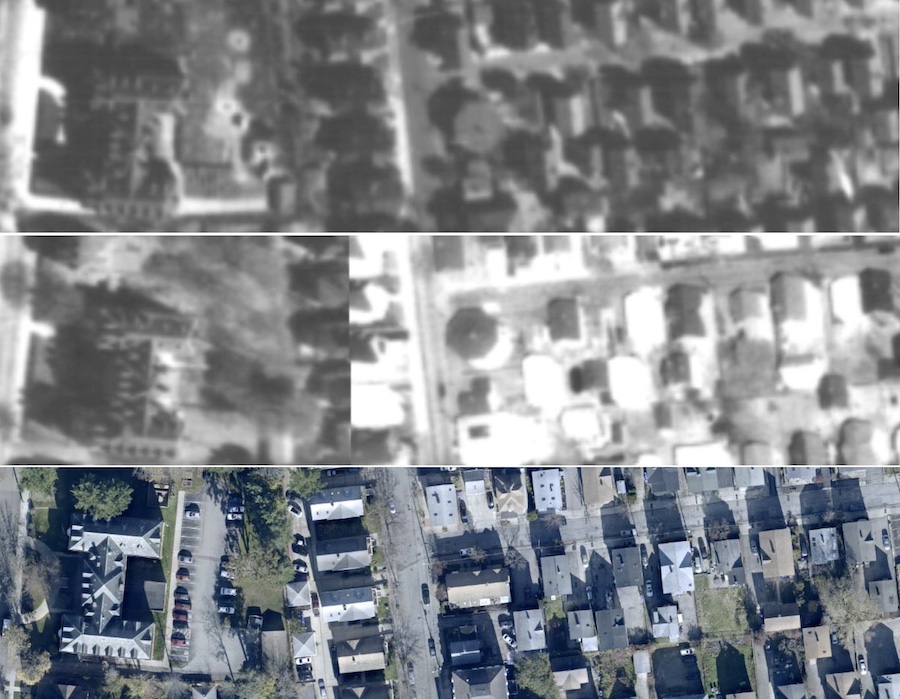
The corner of Ives and Amy Streets in 1939 (top), 1972 (middle), and 2002 (bottom). (Rhode Island Maps and Aerial Mapper). - Providence. The house was located at 307 Knight Street and was built in 1855 by Benjamin Merrill Hubbard. Hubbard resided here until his death in 1882. No longer standing. (Info from Robert Kline's inventory).
- Providence. An octagonal house was located on Locust Street. (Info from Kline's inventory).
- Providence. An octagonal house was located on Pond Street and may have been demolished to make way for the construction of Route 95 in the mid-1960s.
- Providence. The Miles B. Lawson House is located at 669 Public Street. It is a modest, two-story house with a center chimney, which was built circa 1855. Half of the house still has its original bracketing under the cornice. The walls are clapboarded, and the foundation is stuccoed stone. The pitch of the roof is very shallow, and there is what looks like the original, octagonal, central chimney. The home originally belonged to a house painter.
Zillow link
669 Public Street, Providence. (April 29, 2006).
The octagonal chimney at 669 Public Street appears to have been repointed in recent years. (April 29, 2006).
Part of the ornate doorway at the Public Street house. (April 29, 2006).
A closeup of some the Public Street house's surviving bracketing. (April 29, 2006).
Lawson House was restored in 2012-'13 by the Providence Revolving Fund, which received a 2013 Rhody Award for the work from Preserve Rhode Island (PRI) and the Rhode Island Historical Preservation and Heritage Commission (RIHPHC).
Public Street octagon, post glow-up. (January 12, 2014). - Providence. The house was located on Stewart Street between Broad and Pine Streets. (Info from Kline's inventory). This may be the same as the Pond Street house above, as Pond and Stewart once intersected.
- Providence. The house, located at 343 Williams Street, has been demolished. (Info from Kline's inventory).
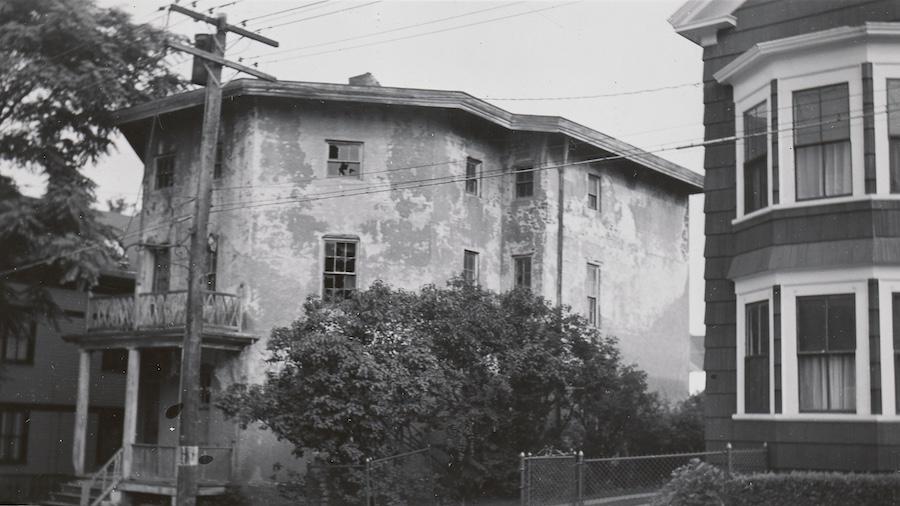
John Hutchins Cady noted the Williams Street octagon was a private school for a time, run by a Miss Hale, and was torn down in 1957. (Providence Public Library, John Hutchins Cady scrapbooks collection, undated).
Providence, in adopting the octagonal, followed the [William H.] Rantlett scheme, although there is one octagonal materially differing from either the Ranlett or the Fowler plan, yet embodying the piazza feature of the latter. This is the house at 343 Williams street, which has five of the planes of an octagonal in their regular sequence, while the other three form a big square ell. There is a wide, overhanging jet which constitutes the roof of a broad piazza, with supporing posts extending to the ground, to which are built piazzas for the two lower stories.—Providence Sunday Journal, November 29, 1914.
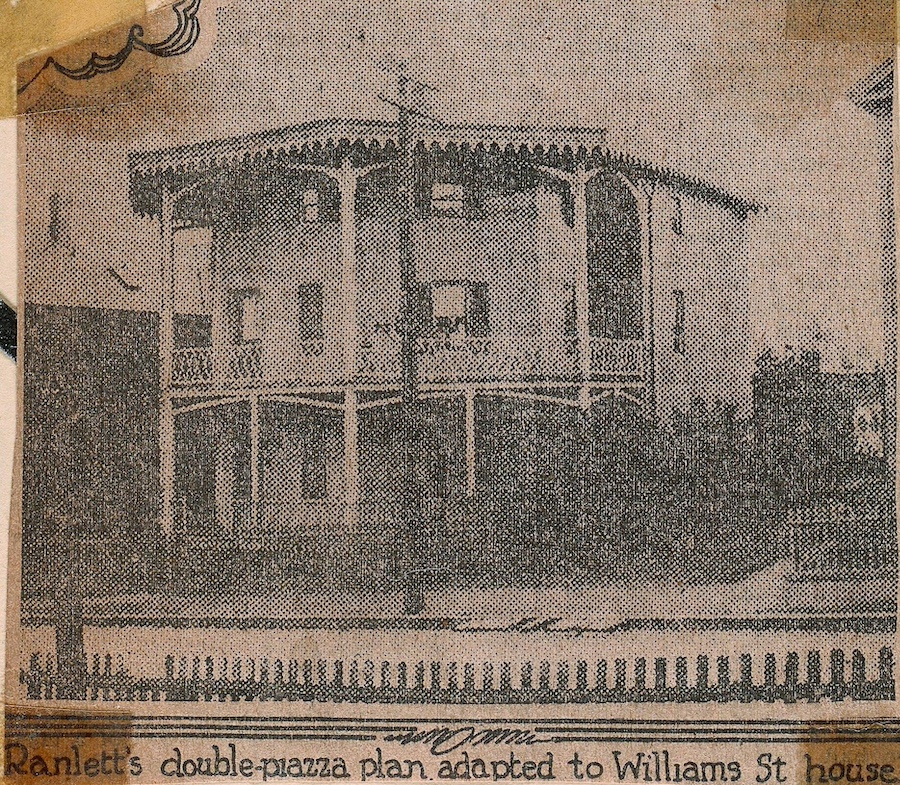
An earlier view of the Williams Street octagon, with double-piazza. (Providence Sunday Journal, November 29, 1914; Providence Public Library, John Hutchins Cady scrapbooks collection). - Providence. 85 West River Street, demolished.
Auction of Real estate. Messrs. Doyle & Joslin sold to-day the large stone and cement octagon house on West River street, containing about thirty tenements, with the lot of land upon which it stands, 71x65 feet, for $1600.—Evening Bulletin, September 14, 1864.
A September 6, 1864, Providence Journal ad announcing the impending sale notes the structure is 3 1/2 stories tall, and that there are a well and cistern on the property. The property belonged to the estate of the late George Olney of Smithfield.
CHOLERA. We learn that a fatal case of cholera occurred yesterday in the "Octagon House" so-called, on West River street, in the north part of the city. It was caused by imprudence in eating, combined with other personal causes.—Providence Evening Press, August 25, 1866.
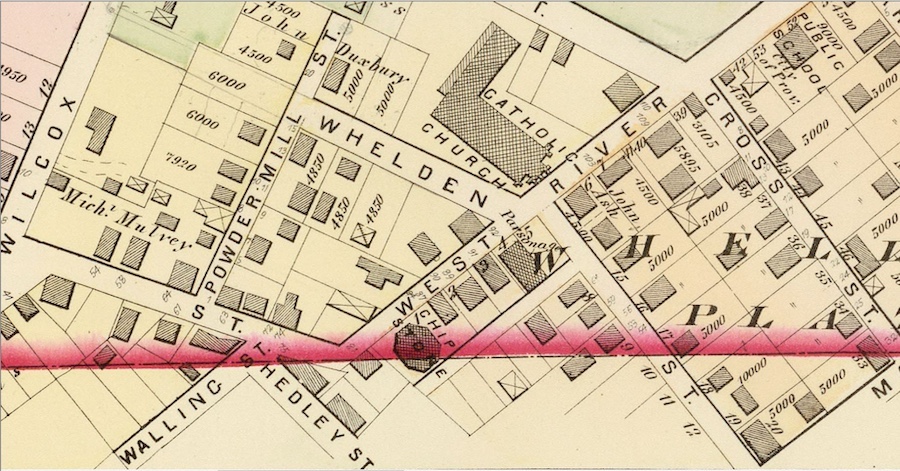
The octagonal tenement appears on the 1875 Atlas of Providence, but not on the 1889 Sanborn Insurance Map of Providence, indicating it was demolished in the interim. (Atlas of Providence, 1875).
[Thanks to Theodore Coleman for uncovering much of the above information about the West River Street octagon.—ed.] - Richmond. The house is located at the corner of Main Street (Route 112) and Shannock Hill Road in the village of Carolina. This wood-frame home was built in 1857 by Albert S. Potter, who was a watchmaker. It is said that he worked at his trade in the cupola of the house, which is quite big, so that he would have light all day long. The two-story building has bracketing under the cornice of the house proper and under the cupola. It is covered with asbestos siding on the exterior. It is now owned by the Carolina Preservation and Band Society.
Albert S. Potter House, Richmond. (July 7, 2006).
If you're not from Carolina, you can't know the octagon house... sitting on Main Street, white with a smaller octagon on top, and for all the world looking like a giant wedding cake. Mr. and Mrs. Potter lived there. Mrs. Potter had a yarn shop in one of the rooms downstairs. Skeins of yarn in reds, blues, and yellows were lined up neatly on shelves too high to reach. Nestled in plastic bins were spools of thread making rainbows in the window light. If anyone gave directions to Carolina, they began with the house of eight sides.—Patty Downey, CarolinaRhodeIsland.com
- Smithfield. The house is located at 108 Farnum Pike (Route 104) in the village of Georgiaville. Called the J.S. Sweet House in the Smithfield RIHPHC report, the commission gives its construction date as circa 1865. It is a two-story residence with a bracketed cornice and two brick, interior chimneys. It has had false stone siding applied to its exterior. There are some five-walled rooms in the house as well as triangular closets. There is no cupola on the very low-pitched roof.
Zillow link

108 Farnum Pike, Smithfield. (April 29, 2006). - South Kingstown. The house, known as Allview Cottage and also as Barney's Pagoda, was once located at Matunuck Beach. It is shown on two different postcards from around 1906. It appears that it was built in the late nineteenth century or early twentieth century. Mr. and Mrs. Barney owned the house in the early twentieth century. It appears to be a wood frame house and had two stories with an encircling porch on the ground level and an observation deck above. On the back of one of the postcards, written in 1912, Mrs. Barney describes the house: "Bright orange & white rooms 15x15 octagon". Quite small, it possibly had only one room on each floor. Built as a summer cottage, it no longer exists.

Barney's Pagoda, from a circa 1906 postcard. (Collection of Louis McGowan).

Allview Cottage, from a circa 1906 postcard. Mrs. and Mr. Barney are standing together at the right. The other two people in the picture are "Mr. Gally at right, and a New York lady at left." (Collection of Louis McGowan). - Warwick. The house is located at 25/27 South Fair Street in the village of Pawtuxet. It is a two-story, hip-roofed structure with one corner built out (which the present owner says was done prior to 1952), changing its original octagon shape into an irregular heptagon. Its exterior walls are shingled. The interior staircase is on the side of the house and not in the center, as Fowler recommended. There is no cupola and only a modern chimney in the center of the roof. Zillow lists a build date of 1905.
Zillow link
An 1890 bird's-eye view map of Pawtuxet shows the South Fair Street octagon.
25/27 South Fair Street, Pawtuxet Village, Warwick. The house is divided into two apartments, one upstairs and one downstairs. (April 29, 2006).
The author and the owner chat about the built-out section at the rear of the South Fair Street house. (April 29, 2006). - Westerly. 45 Urso Drive has a raised central octagon with surrounding porch, perched on one edge of a rectangular structure. The space under the octagon acts as carport. Zillow gives a build date of 1969.
Zillow link

(Google Street View, May 2012).

(Google Satellite View, 2017). - Westerly. Built in 1987, 14 Rock Ridge Road is a two-story octagon with a wing containing a garage on the ground floor and a living room on the second. The property overlooks adjacent Doctor Lewis Pond.
Zillow link

Rock Ridge Road octagon. (March 9, 2024).

Rock Ridge Road first floor plan. (Zillow, 2024).

Rock Ridge Road second floor plan. (Zillow, 2024). - Woonsocket. This home, once located at 316 Grove Street, was demolished around 1981 to make parking space for a tenement house. A rubble stone structure, it was probably unique in Rhode Island in that it had a gable over each of its eight sides. The Woonsocket RIHPHC report labels it the Sabin Pond House, circa 1849. Pond was a local textile manufacturer and built this two-and-a-half-story structure as a family residence. Its proposal for the National Register of Historic Places did not save it, unfortunately.
Sabin Pond House, circa 1900. (Woonsocket Harris Library).

Sabin Pond House, circa 1970s. (Rhode Island Historical Preservation and Heritage Commission report, 1976).

Woonsocket's gable-roofed octagon, circa 1980. (Collection of Louis McGowan). - Woonsocket. 565 Harris Avenue perches on a hillside overlooking the street like a resting spaceship. Zillow lists a build date of 1960.
Zillow link

565 Harris Avenue, Woonsocket, octagon. (Louis McGowan, March 15, 2020). - Woonsocket. 595 Prospect Street is a single level home with an octagonal wing that contains an open concept kitchen and living room. Zillow lists a build date of 1975.
Zillow link
595 Prospect Street, Woonsocket, octagon. (May 13, 2006).
Other Round or Multi-Sided Structures
There have been other multi-sided structures built in the state which do not seem to have a direct relationship with Fowler designs. For example, two twelve-sided, modern homes in Burrillville are known. One is on Cooper Hill Road near the Burrillville/Glocester border, while the other is on Centennial Street. Another twelve-sided building can be found in Woonsocket. It is located at 313 Pond Street and was originally built in 1865 as part of a gasometer. The building houses offices now.
- Burrillville. The building is located at 1910 Victory Highway near Spring Lake Road. The Burrillville Rhode Island Historical Preservation and Heritage Commission (RIHPHC) report claims that it was built in the early twentieth century. The one-story building has been used for a number of purposes, including (in no particular order): the first home of Johnny's Clam Spa, apartments, a florist shop, the office building for water purity in town, and a post office. When we photographed it in April 2006 the Backstreet Beauty Salon was located here. As of August 2023 it was The Grateful Dog, a professional dog grooming business.
The Backstreet Beauty Salon, 1910 Victory Highway, Burrillville. (April 29, 2006). - Central Falls. An 1877 bird's eye view map of Central Falls shows two round buildings located fairly close to each other in the block enclosed by Central Street, Railroad Street, High Street, and Sacred Heart Avenue. They look to be much the same, both with cupolas, and both were probably gasometers.
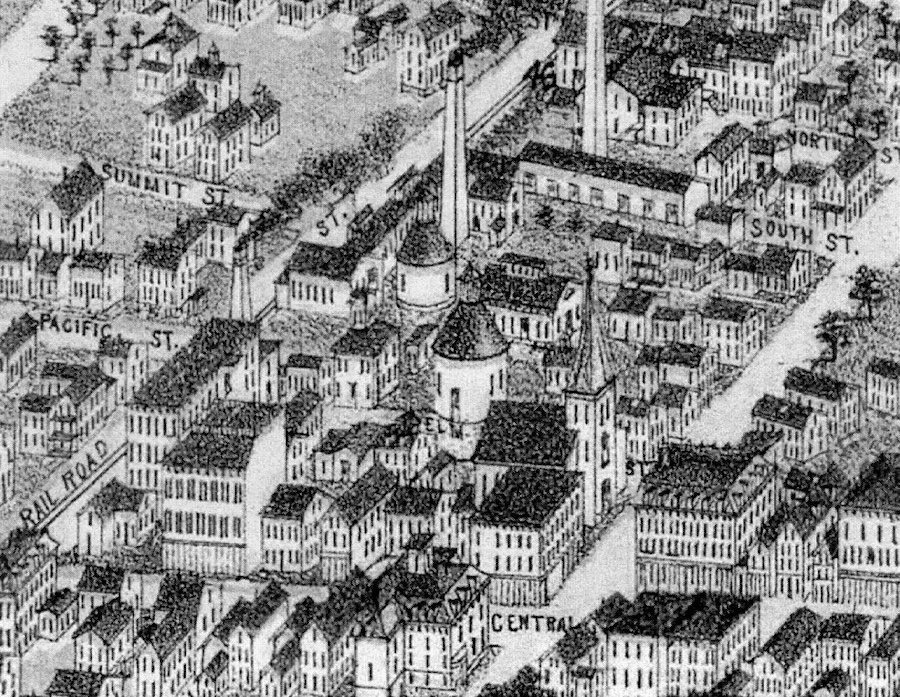
Two possible gasometers in Central Falls, from an 1877 bird's-eye view map.

The two round structures can be seen east of the railway in this 1939 aerial photo (left). Compare to the same area in 2022 (right). (Rhode Island Maps and Aerial Mapper). - Newport. Two round buildings with cupolas, possibly gasometers, are shown on an 1891 bird's eye map in the area enclosed by McAllister Street, Thames Street, Lee Avenue, and Spring Street.
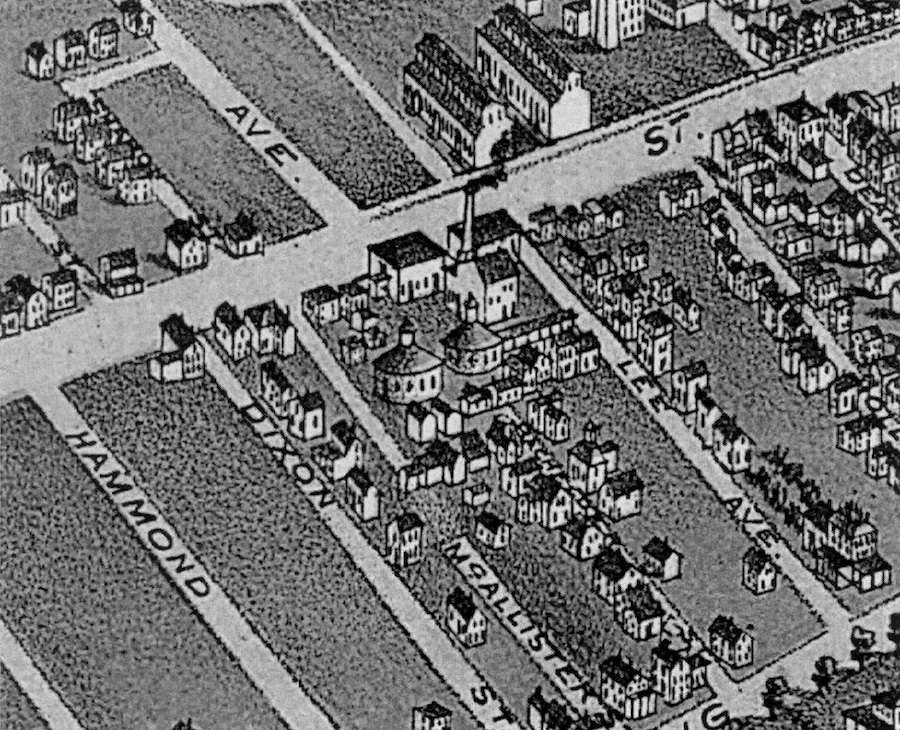
Two possible gasometers in Newport, from an 1891 bird's-eye view map.

The same two round structures can be seen in this 1939 aerial photo (left). Compare to the same area in 2022 (right). (Rhode Island Maps and Aerial Photos). - Pawtucket. As shown on an 1877 bird's eye map of Central Falls, this octagonal building appears to be a small, one-story building with a cupola. It was located on Conant Street, not far from Potter Street. Located in the middle of an industrial area, it does not look to be residential and was possibly a gasometer.
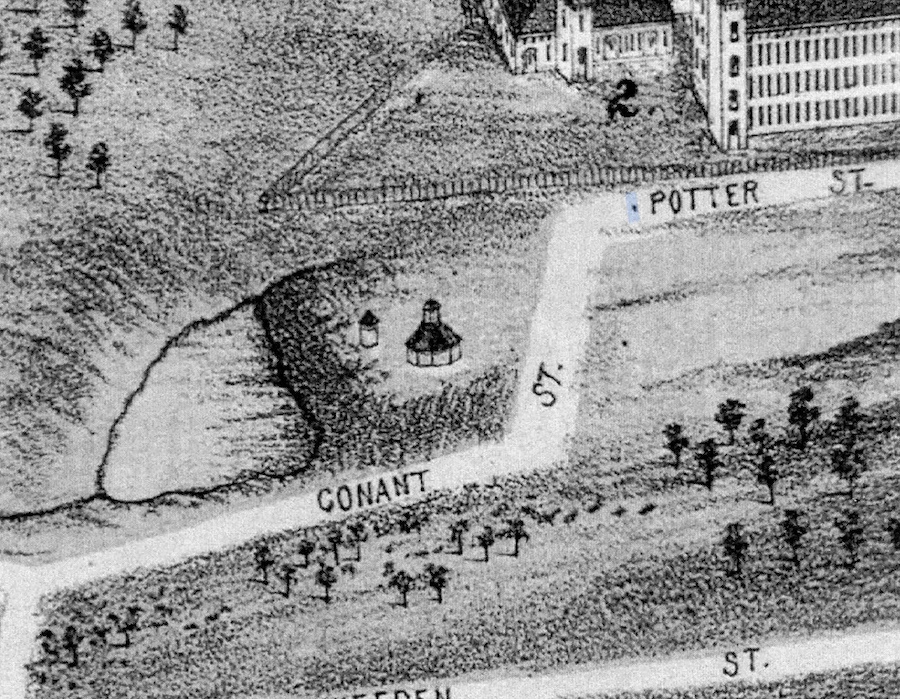
The mysterious Conant Street octagon, from an 1877 bird's eye map of Central Falls. Conant and Weeden Streets can actually be found on modern maps of Pawtucket, not Central Falls, although they are near the border between the two cities. There is a Potter Street in Central Falls, but it's nowhere near the other two streets. - Warwick. An octagon at 1795 Post Road was not a home, but commercial in nature. From about 1970 to '71 it was Jack's Catch, a seafood restaurant run by the Wickford Shellfish Company. The business was auctioned off on June 22, 1971, and then the moveable assets were subsequently auctioned off on November 1, 1972. The next business to occupy the building was Carvel Ice Cream, which did reliable business from about 1973 to 2002. Honey Dew Donuts had a sort of satellite location there from about July 1998 to March 2000. Next came Ozzi's Steakburger/Burger Bar, which opened in June 2008. Around 2012 the business was rebranded, under the same owners, as The Office Kitchen and Bar. The restaurant closed around 2016 or '17. Finally, the building was demolished between August 2022 and September 2023.
Zillow link
The Office Kitchen and Bar. (May 31, 2016).
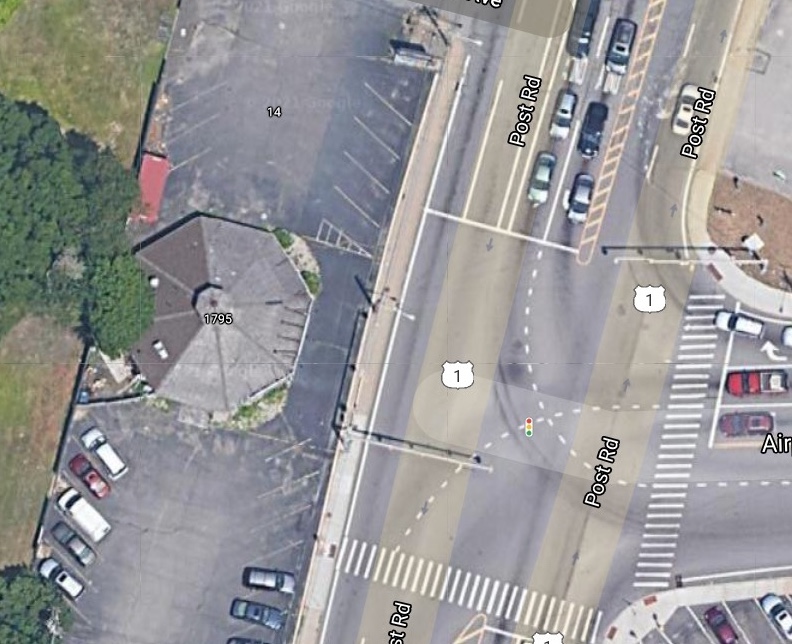
That classic eight-sided shape. (Google Satellite View, 2021).

Nothin' left but a couple of octagonal outlines. (Google Street View, September 2023).
Besides these few examples, there were other multi-sided buildings erected in Rhode Island. Some were merry-go-rounds, some were gasometers, and some were houses, but as we are dealing mainly with octagonal houses in this article, we will not concern ourselves further with other multi-sided buildings here.
Louis McGowan is the former president of the Johnston Historical Society and an avid collector of postcards. He is the co-author of the Images of America books Johnston (1997) and Johnston II (1999), and the Postcard History Series book Providence (2006). He resides in Providence.